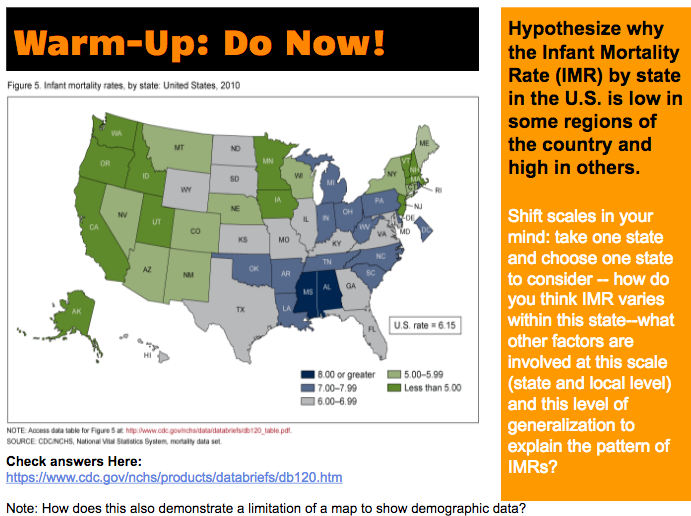|
Today we will go over the Population (DTM + Population Pyramids) FRQ results and other Population FRQs and go over Population MCQ results. After that, we will discuss concepts, terms and important key issues for the first few Key Questions.
Key Questions We Will Discuss Today:
Helpful resources for today's class:
0 Comments
Today, you will complete a 25 question MCQ on Chapter 2: Population. Afterwards, we will begin discussing Chapter 3: Migration. Link to today's presentation on Immigration: Unit 2: Migration PPT Hw: Begin reading CH. 3: Migration; begin work on study guideBegin reading Chapter 3 for both Fouberg and Rubenstein.
For Fouberg, read Key Questions 1-2 (pgs. 76-88)
While the topics are similar, they are presented in slightly different ways and some of the vocabulary is different. You will need to know vocabulary terms presented in both books. Begin completing the study guide (will be dropped in your APHG folder). Complete sections for Key Questions 1-2. Today you will take another formative FRQ on DTM, Population Pyramids and Dependency Ratio. Afterwards, we will take a cookie quiz. HW: Study for Formative MCQ next Monday30 multiple choice questions; 25 minutes to answer.
Use the following to help study:
HW: Study for DTM + Population Pyramid FRQ for next class
HW: Finish Study Guide, Key Issue #4
HW: Study for Formative FRQ on Friday, sep 15To prepare for the Unit 2 Formative FRQ #1 (early key issues/questions for Population), please work on the study guide.
The Chapter study guide has been placed in your APHG Drop folder. Focus on completing sections of the study guide for Key questions/issue #1 and #2 and #3. You will not need to know how to calculate Doubling Time or read Population Pyramids, or read the DTM, but understanding these models and how they help us answer the key issue questions is potentially helpful. You will be tested on Doubling Time, Population Pyramids and DTM at a later date--not Friday. For Friday, focus on patterns and trends with population distribution and demographic dynamics (complexity of factors and conditions that can affect where people live and the rate at which a population increases or decreases). Consider examples we've focused on (Japan, Singapore, India, etc.) The FRQ will require you to know how to respond to the key issues:
Today we will focus on Fouberg Chapter 2 Key Question, "why do populations rise or fall in a particular place?". We will look at the Demographic Transition Model (DTM), and compare population theories (Malthus vs. Boserup) and discuss what critics say about Malthus and the DTM. HW: Watch Doubling Time Video, finish doubling time calculations; study Fouberg ch. 2 key questions 3-4; take notes & study -- next class is population pyramids & healthToday, we will go over your results on the MCQ and FRQ. Afterwards, we will play another round of GapMinder games -- today is a horse race! We will then discuss the 4 homework questions as it relates to understanding population growth and decline and policy decisions governments make to grapple with the population challenges they may face that affect all aspects of society (infrastructure, economics, resources, governance, etc.) For this, we will then focus on Singapore-- it is where we are living so why not understand a bit more of what allows MOST of us at SAS to be here. Yes, population policies affect the lives of expats. Here are helpful links for today's class:
HW: Read Chapter 2 (fouberg);
|
| | |
Author
Bookmark this page so that you can keep up with what is covered in class (esp. if you are absent).
Archives
May 2018
April 2018
March 2018
February 2018
January 2018
December 2017
November 2017
October 2017
September 2017
August 2017

 RSS Feed
RSS Feed